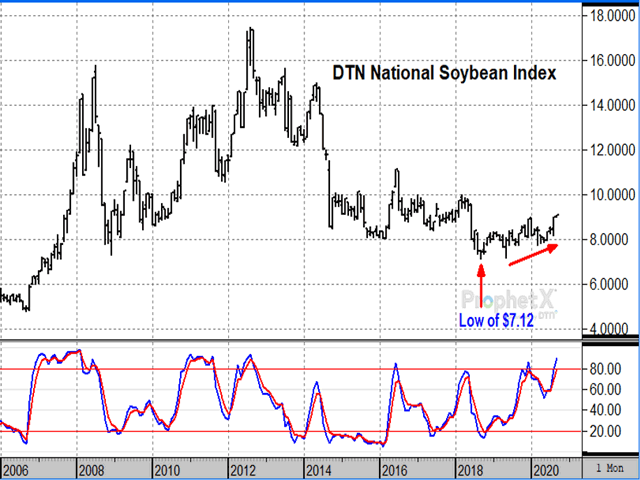Todd's Take
Soybean Bullishness Reemerges
In February 2019, I remember being at the National Farm Machinery Show in Louisville, Kentucky, trying to explain the soybean market to an audience eager to hear DTN's weather and market outlook. At that point, we were seven months and several layers of new tariffs into the trade dispute with China.
I had the unpleasant task of showing how USDA was estimating 910 million bushels (mb) of U.S. ending soybean stocks for 2018-19, a historically high ending stocks-to-use ratio of 22% and an even higher surplus looked likely for 2019-20.
When I showed a chart of previous soybean prices when USDA estimated ending stocks-to-use ratios of 22% or more, the inflation-adjusted result was cash prices in the $6s. As you can imagine, there was a collective groan in the room, including mine.
Little did we know then, but the low in DTN's index of U.S. cash soybean prices was already behind us. The price of $7.12 a bushel, made on Sept. 18, 2018, stands as the lowest close since 2007. Since then, prices have endured the back-and-forth drama of contentious negotiations, demand fears related to African swine fever and USDA ending stocks estimates in excess of 1 billion bushels (bb) but have not traded below $7.12.
Fortunately for U.S. soybean producers, DTN's national average never did record a price in the $6s and I credit two primary factors. The first, payments from the Market Facilitation Program (MFP) in 2018 and 2019 helped producers defray some of the losses related to the trade dispute and helped prevent panic selling in soybeans.
The second, and larger rescue for soybean prices, last year's (2019) awful planting conditions. Wet spring weather imposed its own set-aside program and cut soybean acres by 13 million. For many, the solution was harsh but may have saved the U.S. market from a 1.5 bb carryout.
P[L1] D[0x0] M[300x250] OOP[F] ADUNIT[] T[]
The emergence of coronavirus in 2020 brought another bearish challenge to soybean prices, potentially threatening demand not only from China, but the entire world. Even in that dire situation, soybean prices held it together. DTN's National Soybean Index briefly traded a low of $7.73 on March 16, 2020, in the height of pandemic concerns.
More recently, soybean prices have experienced the most bullish surge since the trade dispute with China began. Unusually hot and dry weather in August knocked soybean crop ratings down from their highest level in at least 10 years and a lower yield estimate from USDA now seems likely in the next World Agricultural Supply and Demand Estimates (WASDE) report on Sept. 11.
The recent unexpected revival of soybean prices, however, is much more about what is happening in China and the world in general than it is about any crop problem in the U.S.
As explained in my Aug. 24 Todd's Take column, "What Is Happening in China?" ( https://www.dtnpf.com/… ), China's economy is recovering from COVID-19 and food prices are high. Disastrous flooding in southern China this year did not hurt China's soybean crop areas, but likely added to the difficulties of obtaining and transporting food. Meanwhile, China has been such an aggressive buyer in 2020 that Brazil appears to be out of soybeans until the next harvest in early 2021. The U.S. is currently the world's main supplier of soybeans for the next few months.
As of Sept. 3, China has signed on for at least 507 mb of new-crop soybeans from the U.S. and possibly more if some are hiding in the unknown category. Market veterans will be quick to point out that sales don't always equal exports as China is notorious for making cancelations.
In this case, however, after minimizing U.S. soybean purchases during the past two years, China's food supplies legitimately appear to be running on empty.
In South America, farmers see high prices and are eager to get planting this fall. In Brazil, where FOB soybean prices are at their highest in nearly two years, the current $11.35 per bushel for October is 63 cents above the FOB price at the U.S. Gulf and almost guarantees an increase in soybean acres.
Weather, of course, will have the final say and La Nina conditions this fall may limit precipitation chances in southern Brazil and Argentina. There is plenty of uncertainty to navigate through in the new season.
For now, we can't help but notice that the current bull move in U.S. soybean prices has more potential than any time since the trade dispute with China began. As information out of China is always suspect, it is difficult to say how much demand for U.S. ag products still exists, but judging by prices, China's shortages look far from being solved.
Technically, the series of higher lows on the monthly chart of DTN's National Soybean Index is promising, but cash prices near 2-year highs are likely to be rewarded with farmer selling (as they should).
From a larger perspective, we see world soybean demand has not only been the clear growth leader of major crops for over 30 years, it continues to show remarkable resilience, even in the large bearish hurdles encountered since 2018.
USDA estimates 367.90 million metric tons (mmt) or 13.52 bb of soybeans will be consumed in 2020-21, a new world record and 4.5% more than the previous year. In spite of the bearish hits of the past two years, the world's desire for more protein continues to be the dominant driver of world ag trends and is a strong supporter of soybean prices.
Todd Hultman can be reached at Todd.Hultman@dtn.com
Follow him on Twitter @ToddHultman
(c) Copyright 2020 DTN, LLC. All rights reserved.




